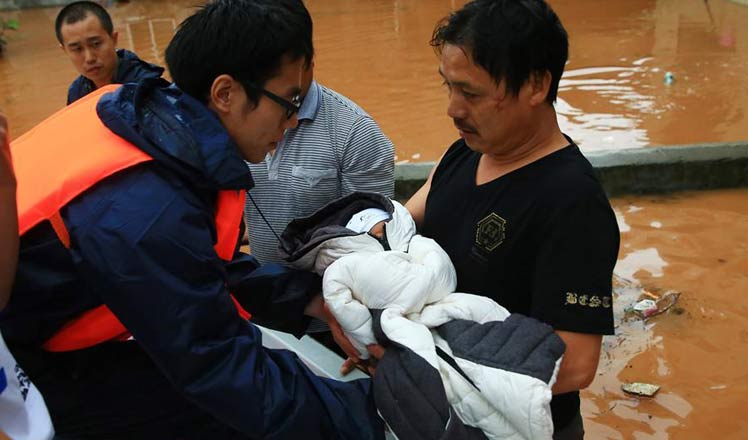How to avoid a China-Japan conflict at sea
Updated: 2016-06-18 07:43
By Zhou Bo(China Daily)
|
||||||||
On June 9, Japan's Defense Ministry said a Japanese naval destroyer had detected a Chinese frigate entering the waters near Diaoyu Islands (which the Japanese call Senkaku Islands) and lodged a serious protest with the Chinese ambassador to Tokyo. And Japan's Chief Cabinet Secretary Yoshihide Suga said it was the first time a Chinese naval ship had entered the waters contiguous of the island chain.
The truth became clear gradually: the Japanese destroyer had actually seen a Russian flotilla, and only after the Japanese ship ventured into the waters off the island chain (apparently to check out the Russian flotilla) that a Chinese frigate did so to monitor the Japanese vessel.
For Japan, a Chinese naval vessel entering the waters off the Diaoyu Islands indicates that Beijing probably wants to take new risks to escalate tensions in the already volatile waters. Japanese media say that if China's actions go unchecked, its naval vessels will one day enter the 12-nautical-mile territorial sea of the islands, leading to a showdown between Beijing and Tokyo.
This assumption is irrational.
First, the entire world knows China and Japan have a sovereignty dispute over the Diaoyu Islands. The Japanese government, however, insists there is no dispute, although it would like to hold talks with China on the issue. This is self-contradictory: if there is no dispute, why should the two sides talk?
Besides, since the Diaoyu Islands are Chinese territory, China could say the Japanese destroyer entered their contiguous waters and claim it to be an unprecedented incident that needs to be addressed seriously.
Second, the incident reveals Japan's double standard when it comes to freedom of navigation. Even if Tokyo believes the Chinese frigate entered "Japan's contiguous zone", no international or Japanese law prohibits it. Also, Japanese EP-3 and P-3C aircraft have entered China's undisputed exclusive economic zone east of Zhoushan Islands in Zhejiang province for surveillance and reconnaissance from time to time, but when Chinese flotillas pass through the international sealane in any Japanese strait, Japan's Self-Defense Force sends ships and aircraft to track and monitor their movements.
Third, until the June 9 incident only Chinese and Japanese coast guard, not naval, ships patrolled the waters off Diaoyu Islands. If that is a tacit understanding between the two sides to not escalate tensions, then Japan violated it on June 9. The Chinese frigate did enter the contiguous zone of the islands, but it only followed the Japanese destroyer as a counter-measure. This shows Japan, not China, has "unilaterally heightened tensions".
However neither China nor Japan wants such an incident to snowball into a full-blown conflict. So what should be done?
To begin with, China and Japan should follow the Code for Unplanned Encounters at Sea, which both have pledged to honor. CUES has a set of communication and operational procedures, for example, to prevent a ship from getting too close to vessels in formation, and avoid aiming guns, missiles or fire control radars at other vessels or aircraft it encounters.
The Chinese navy has held quite a few exercises with foreign navies, including the US Navy, on how to fully observe CUES. The Chinese and Japanese navies could do the same to build confidence and familiarize themselves with the procedures.
China and Japan should also expedite negotiations to establish the China-Japan Maritime and Air Liaison Mechanism, which, among others, would allow direct communication between captains of ships and pilots of aircraft during "close encounters". The procedures of the mechanism would be similar to those in CUES and the Rules of Behavior for Safety of Maritime and Air Encounter concluded between China and the US.
The Japanese government's decision in 2012 to "nationalize" the Diaoyu Islands caused suspension of the negotiations. Since the Chinese and Japanese "Air Defense Identification Zones" to a large extent overlap with each other and they cover the same islands that both claim as their own territories, the issue has become more complex.
It remains to be seen how the two sides use their wisdom to move between principle and flexibility, in order to chart out a new and fruitful path, because the June 9 incident is a chilly reminder that the issue has to be settled before it is too late.
The author is an honorary fellow with the Center of China-American Defense Relations, Academy of Military Science.
(China Daily 06/18/2016 page5)
- Planned Obama, Dalai Lama meeting protested
- Gravitational waves detected for second time: scientists
- 48-hour 'silence regime' starts in Syria's Aleppo
- UN Security Council adopts resolution on Libya arms embargo
- US extradites top drug lord 'El Guero Palma' to Mexico
- Houston firm joins China clean energy project

 Photographer wants people to care for endangered animals
Photographer wants people to care for endangered animals
 Iconic pagodas turn into a dreamland in infrared photos
Iconic pagodas turn into a dreamland in infrared photos
 Mass yoga events ahead of International Yoga Day
Mass yoga events ahead of International Yoga Day
 Thangka worship activity held in Lhasa
Thangka worship activity held in Lhasa
 Top 10 most valuable car brands in the world
Top 10 most valuable car brands in the world
 Floods cause havoc across south, central China
Floods cause havoc across south, central China
 Top 10 Chinese cities with highest housing rent
Top 10 Chinese cities with highest housing rent
 Polish art rediscovers its roots
Polish art rediscovers its roots
Most Viewed
Editor's Picks

|

|

|

|

|

|
Today's Top News
Abe's blame game reveals his policies failing to get results
Ending wildlife trafficking must be policy priority in Asia
Effects of supply-side reform take time to be seen
Chinese State Councilor Yang Jiechi to meet Kerry
Chinese stocks surge on back of MSCI rumors
Liang avoids jail in shooting death
China's finance minister addresses ratings downgrade
Duke alumni visit Chinese Embassy
US Weekly

|

|







